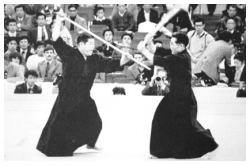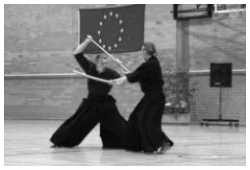The word Jodo translates as the 'the way of the staff' and is the Modern interpretation of the samurai art of Jojutsu. Jodo is a Kata based art which is practiced with a partner [opponent], one person using the Jo and the other using a Bokuto [wooden practice sword]. The Kata, when performed well, are dynamic and fluid in nature, an element of the practice being that the kata should be performed with the feeling of real combat [Shinken shobu] and as no protective wear is used a degree of courage is required if the kata are to be practiced in the correct spirit. It should be stressed though that injuries are not common and Jodo is commonly practiced by both Men and Women of all ages.
The Jo itself is usually made from either White or Red Japanese Oak and carries with it none of the mythology and pride of ownership attached to the Japanese sword, it is just a stick! It was often the preferred weapon of Buddhist monks in feudal times as it was in keeping with their non materialistic ideals and unlike with the ultra sharp Japanese sword, they were able to defend themselves without necessarily causing lethal injuries to their attacker[s].
As a weapon it is very versatile, it can be held in a number of ways, using both ends equally when making attacks or defence. In modern terms the practice of Jodo is beneficial to health in that both sides of the body are used equally, so the development of muscle, tendons etc is in balance and due to the dynamic movement it provides good aerobic excercise.
Jodo origins trace back to Muso Gonnosuke katsukichi. Gonnosuke had studied the use of a number of different weapons during his time with the 'Tenshin Shoden katori Shinto Ryu' [ a famous traditional school still extant today] in the late sixteenth century and had eventually begun a tour of Japan in order to test his skills. In due course he encountered the famous swordsman 'Miyamoto Musashi', a duel ensued with Gonnosuke using a 'Rokushakubo' or six foot staff and Musashi using the two sword method he was to become famous for. Gonnosuke was defeated but, uncharacteristically for the time, was allowed to live by Musashi.
Gonnosuke,dejected, then spent the next few years enlarging his knowledge and further improving his skills until, as the story goes, after a period of meditation at the Kamado shrine on Mount Homan he got the inspiration to devise a method using a staff which was shorter than usual, making it more versatile, but still long enough to have a reach advantage over a sword. After taking some time to develop his new method, Gonnosuke sought out Musashi and again entered into a duel with him, this time Gonnosuke emerging the victor and repaying Musashi's original favour by not taking his life. Gonnosuke then formalized his new method, giving it the name 'Shindo Muso Ryu'.
The teaching of 'Shindo Muso Ryu Jojutsu' was passed from headmaster to headmaster until the title fell to Takaji Shimizu Dai Sensei in the early 1900's [ Dai Sensei meaning 'Great Teacher' ]. The practice of Shindo Muso Ryu Jojutsu was first introduced to the Z.N.K.R.[All Japan Kendo Federation] in 1956 and shortly after, a study commission was formed to explore the possibility of forming a syllabus of Jo practice which would be accessible to more people. In 1963 a committee was formed under the chairmanship of Shimizu Dai Sensei to produce a set of kata which would be representative of the Jo tradition and in 1968 the 'Zen Nippon Kendo Renmei Jodo Gata' was formed. Since then Seitei [fixed system] Jodo has continued to develop under the umbrella of the Z.N.K.R. and is practiced alongside it's parent Shindo Muso Ryu Jojutsu in many countries throughout the world.
|
|

Jo: Hiroi Tsunetsugu sensei
Tachi: Yoneno Kotaro sensei |
|

Jo: Steve Boyes sensei
Tachi: Keith Rose sensei
|
|
|